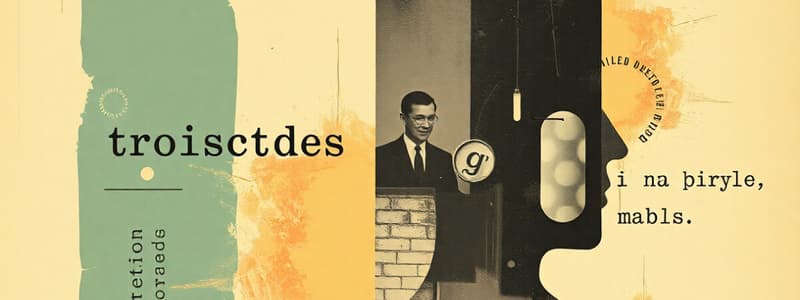Podcast
Questions and Answers
Which of the following sentences contains a transitive verb used correctly?
Which of the following sentences contains a transitive verb used correctly?
- They arrived early.
- The cat slept soundly.
- He kicked the ball. (correct)
- She smiled gently.
Identify the direct object in the following sentence: 'The chef prepared a delicious meal.'
Identify the direct object in the following sentence: 'The chef prepared a delicious meal.'
- The chef
- A delicious meal (correct)
- Delicious
- Prepared
Which characteristic is essential for a verb to be classified as transitive?
Which characteristic is essential for a verb to be classified as transitive?
- It expresses a complete thought.
- It requires a direct object to complete its meaning. (correct)
- It can stand alone as the predicate of a sentence.
- It describes a state of being.
In the sentence, 'The artist painted a vibrant landscape,' what part of speech is 'landscape'?
In the sentence, 'The artist painted a vibrant landscape,' what part of speech is 'landscape'?
Which of the following sentences does not contain a transitive verb?
Which of the following sentences does not contain a transitive verb?
Flashcards
Transitive Verb
Transitive Verb
A verb that takes a direct object.
Direct Object
Direct Object
A noun that receives the action of a transitive verb.
Transitive Sentence Structure
Transitive Sentence Structure
Subject + Transitive Verb + Direct Object
Examples of Transitive Verbs
Examples of Transitive Verbs
Signup and view all the flashcards
Identifying the Subject
Identifying the Subject
Signup and view all the flashcards
Study Notes
- A verb describes an action and can be transitive, intransitive, linking, or helping.
Transitive Verbs
- A transitive verb accepts a direct object, which is a noun that receives the verb's action.
- Transitive verbs cannot stand alone as a sentence's predicate.
- They connect the subject, the action, and the direct object.
- The structure is subject + transitive verb + direct object.
- Examples of transitive verbs: throw, eat, write, drive.
- To identify a transitive verb, find the subject, the action (verb), and then determine if there's a direct object answering "what?" or "whom?"
- Example 1: "Neil caught the ball." Neil (subject) + caught (transitive verb) + the ball (direct object).
- Example 2: "Aaliyah read a book." Aaliyah (subject) + read (transitive verb) + a book (direct object).
- Example 3: "When the sun set, Stephanie rode her horse to the store." Stephanie (subject) + rode (transitive verb) + her horse (direct object).
- Identifying a direct object confirms that the verb is transitive, even in complex sentences.
Transitive Verbs vs Intransitive Verbs
- Intransitive verbs can stand alone as the predicate of a sentence, and do not take a direct object.
- Intransitive verbs are often paired with adverbs or adverbial phrases that describe when, where, or how the action occurs.
- The subject completes the action without needing an object.
- Examples of intransitive verbs: stands, sleeps, stops.
- Example 1: "Julia stands." or "Despite it all, Julia stands." Stands is intransitive because Julia performs the action without acting upon an object.
- Example 2: "Julio sleeps at night." or "Amidst the stary light, Julio slept soundly." Sleeps is intransitive because Julio performs the action without acting upon an object.
- Example 3: "Adorlee stopped." or "After a long hike and numerous challenges, Adorlee stopped." Stopped is intransitive because Adorlee performs the action without acting upon an object.
- Verbs commonly used intransitively, such as "stop," can function as transitive verbs if they take a direct object.
- Example: "Adorlee stopped the car." Here, "stopped" is transitive because "car" is the direct object.
- Linking verbs are often intransitive, connecting a subject to additional context.
- Example: "Maria feels excited for tomorrow." "Feels" is a linking verb and intransitive, as "excited" is not a direct object.
- Other linking verbs: look, sound, become.
- Whether a verb is transitive or intransitive depends on its function in the sentence, specifically if it has a direct object.
Studying That Suits You
Use AI to generate personalized quizzes and flashcards to suit your learning preferences.




